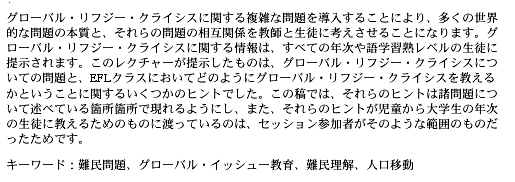
Abstract
Introducing complex issues about the global refugee crisis allows teachers and students to consider the nature of, and interrelationships between,
a number of global issues. Information concerning the global refugee crisis can be presented to students of all ages and language proficiency levels.
This lecture provided a brief discussion of some concerns, and suggestions for raising global refugee concerns in EFL classrooms.
In this paper, teaching suggestions appear where relevant to the issues being described, and the focus on teaching for age levels from children to
university-age reflects the interest expressed by session participants.
Keywords: Refugee concerns, global issues education, refugee awareness, global displacement
|
